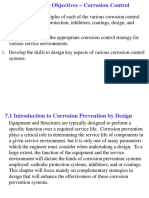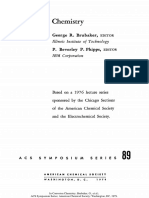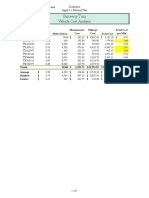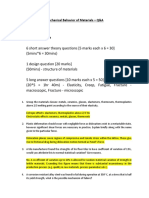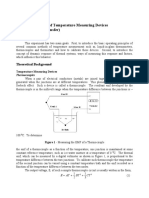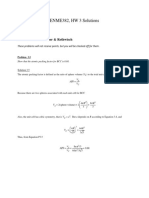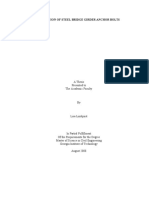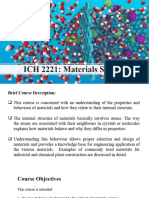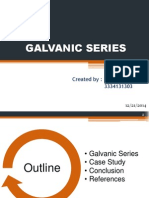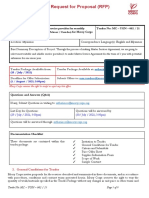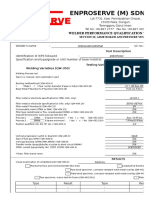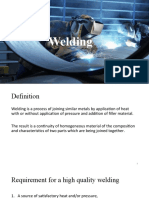Corrosion Prevention
Corrosion Prevention
Uploaded by
andrew myintmyatCopyright:
Available Formats
Corrosion Prevention
Corrosion Prevention
Uploaded by
andrew myintmyatOriginal Description:
Copyright
Available Formats
Share this document
Did you find this document useful?
Is this content inappropriate?
Copyright:
Available Formats
Corrosion Prevention
Corrosion Prevention
Uploaded by
andrew myintmyatCopyright:
Available Formats
Technical Bulletin
Number: 2006/11 June 2006
DESIGN AND LAY-OUT FOR CORROSION PREVENTION (continued)
Welding aspects relating to design It is very important to take weldability into account when equipment is being designed. As stated earlier, welded joints are often preferable to bolted or riveted joints assuming high welding quality. If crevice corrosion is a risk, then a crevice-free full-penetration weld must be used. Figure 4 illustrates how correct welding design can minimise corrosion risks.
Poor design Avoid crevice by: Rivet Good design Poor design Good design Metal A Weld Avoid dilution of Metal B by A at weld by: Tube of metal B Wrought bar Avoid end grain attack by (overlay) weld Pad of metal B
Figure 7: Galvanic corrosion of an aluminium instrument air line at the location of the joint with carbon steel
or
welds Avoid crevice by full penetration weld
Figure 4: Weld design aimed at reducing the risk of corrosion
Crevices are present between the pipes and the pipe plates in the normal pipe/plate welded joints on heat exchangers. The risk of either crevice corrosion or stress corrosion is high in these crevice areas, particularly when the corrosive components in the crevices can build up due to the evaporation of water. Crevices in pipe/plate joints can be avoided by using the internal bore welding technique. Of course this type of construction is quite expensive, but in critical situations, designs such as this it should be considered. Design aspects in relation to drainage of vessels It is essential that vessels be constructed so that they can be fully drained when the installation is taken out of service. Figure 5 illustrates design faults resulting in incomplete drainage; design solutions are also illustrated. Residues left behind (even small quantities) can result in corrosion damage. The increasing concentration of the contaminants due to evaporation of water, as well as product deposits, form ideal conditions for pitting and crevice better poor poor better corrosion.
Galvanic corrosion in relation to design The risks of galvanic corrosion occurring should be reviewed at the design stage. If a combination of different metals cannot be avoided, the following measures can be taken: Use materials that are close to each other in the galvanic series. Avoid unfavourable surface effects - the corrosion of a small anodic area will be greatly accelerated if it is connected to a large cathodic area. Isolate where possible: break the circuit between the two metals as shown in figure 6. If a coating is used, ensure that it is adequately maintained; a coating applied to anodic material can result in very serious local attack at coating defects. Bring a third material into metallic contact with both materials. This third material must be anodic to (less noble than) the other two metals. The above illustrates that in some cases galvanic corrosion can be used as a corrosion protection technique (cathodic protection). An example is the use of galvanised steel for atmospheric corrosion protection. It should also be stated that the risk of galvanic corrosion should not be exaggerated. Galvanic corrosion can only take place if an electrolyte (moisture) is present - galvanic corrosion is not possible in a gaseous atmosphere or dry air. Many combinations of materials that lie far Insulating sleeve apart in the galvanic series will not or will Insulating scarcely be liable to Nut washer corrosion. For example aluminium connected to Bolt stainless steel and exposed in a moist atmosphere will not result in significant galvanic corrosion. Valve Pipe Aluminium connected to carbon steel will however result in Threaded flange Gasket serious galvanic Figure 6: Correct isolation for preventing corrosion of the galvanic corrosion aluminium.
poor
better
poor
better
Figure 5
Figure 7 (see first page) shows galvanic corrosion (from the atmosphere) of an aluminium instrument air line that was connected to a carbon steel line. During the design of the process installation it was assumed that connecting the aluminium instrument air line to the process lines was an inexpensive solution, but it had disastrous consequences for corrosion. Erosion corrosion (cavitation) in relation to design The mechanism of erosion corrosion is not just related to the environment, but is also closely connected to the design. The risk of erosion corrosion increases if the design and layout lead to turbulence. Narrowing in pipework and incorrectly installed packing can result in erosion corrosion. Figure 8 illustrates how this problem can be solved using correct design and correct packing assembly.
pump manway discharge
Inlet H2SO
Sacrificial plate
- 98% sulphuric acid (hygroscopic) - atmospheric temperature - carbon steel - 2mm corrosion allowance
Overflow line to sewer Sacrificial plate
Figure 9: Storage tank for concentrated sulphuric acid designed to prevent erosion corrosion
erosion corrosion
poor a. constriction in tube erosion corrosion
better
Figure 10 illustrates an example of erosion corrosion in a Tpiece of a piping system for concentrated sulphuric acid. In this T-piece turbulence and as a consequence damage to the protective FeSO4 layer can hardly be avoided.
poor
better
Author: Mr. G. Notten (Senior Corrosion Engineer) Reactions and/or questions: e-mail: tb@vecom.nl
Figure 8: Prevention of erosion corrosion by avoiding local turbulence
How erosion corrosion can be avoided by using design measures can be illustrated by using a storage tank for concentrated sulphuric acid as an example. In principle concentrated sulphuric acid can be stored in carbon steel storage tanks, assuming that the protective FeSO4 layer that forms on carbon steel in concentrated sulphuric acid is not damaged. This protective layer may be damaged by: Turbulence or high flow rates (> 0.6 m/sec); o o Temperatures above 40 C to 50 C; Thinning of the concentrated sulphuric acid. Erosion corrosion can be expected in the bottom plates of sulphuric acid storage tanks, under the sulphuric acid supply line. This problem can be solved by using a sacrificial plate on the bottom under the sulphuric acid supply pipe and by shortening the pipe (see figure 9). Concentrated sulphuric acid and SO3 vapours are very hygroscopic. A consequence of this is that moisture can enter the tank via the ventilation pipe on the roof of the tank and via the overflow pipe (in the wall) to the drain. The tank roof will be subject to corrosion around the ventilation pipe and also the tank wall under the overflow pipe, due to the formation of diluted sulphuric acid (reaction of SO3 with H2O). Allowing the ventilation pipe and the overflow pipe to penetrate the tank as illustrated in figure 9 can solve this problem.
Figure 10: Erosion corrosion in a T-piece from a sulphuric acid line
You will find Vecom in the Netherlands (Maassluis, Rotterdam, Bergen op Zoom, Heerlen, Enschede, Hoogezand) - Belgium (Ranst, Mouscron) Germany (Hamburg, Wetzlar) - United Kingdom (Bury, Barnsley, Sheffield) and Denmark (Lsning)
You might also like
- Chapter 6 Mankiw (Macroeconomics)Document36 pagesChapter 6 Mankiw (Macroeconomics)andrew myintmyat100% (1)
- Corrosion Lecture 19 Corrosion Prevention by DesignDocument23 pagesCorrosion Lecture 19 Corrosion Prevention by DesignkovveeNo ratings yet
- Dislocation Mobility and Hydrogen - A Brief ReviewDocument6 pagesDislocation Mobility and Hydrogen - A Brief ReviewIchsan HakimNo ratings yet
- Corrosion Chemistry PDFDocument429 pagesCorrosion Chemistry PDFCrissAngelica100% (1)
- Protest Instructions 1. Scope 1.1Document5 pagesProtest Instructions 1. Scope 1.1andrew myintmyatNo ratings yet
- Regression Analysis PDFDocument205 pagesRegression Analysis PDFandrew myintmyat100% (2)
- Apply 2-1 Briteeny Taxi - KoAndrewDocument1 pageApply 2-1 Briteeny Taxi - KoAndrewandrew myintmyatNo ratings yet
- Challenges in Corrosion: Costs, Causes, Consequences, and ControlFrom EverandChallenges in Corrosion: Costs, Causes, Consequences, and ControlNo ratings yet
- Corrosion and Materials Selection: A Guide for the Chemical and Petroleum IndustriesFrom EverandCorrosion and Materials Selection: A Guide for the Chemical and Petroleum IndustriesNo ratings yet
- Corrosion Engineering and Cathodic Protection Handbook: With Extensive Question and Answer SectionFrom EverandCorrosion Engineering and Cathodic Protection Handbook: With Extensive Question and Answer SectionNo ratings yet
- Solutions of Practice Questions 5Document6 pagesSolutions of Practice Questions 5kshitij90100% (1)
- Types of Electrochemical CorrosionDocument10 pagesTypes of Electrochemical CorrosionAaka Sh100% (1)
- Lec04 - Imperfections in SolidsDocument16 pagesLec04 - Imperfections in SolidsIan BecerroNo ratings yet
- Material Tech Questions Solved BitsDocument22 pagesMaterial Tech Questions Solved BitsBalakumarNo ratings yet
- NR 320807 Corrosion EngineeringDocument5 pagesNR 320807 Corrosion EngineeringSrinivasa Rao GNo ratings yet
- Water TechnologyDocument58 pagesWater TechnologyAdi Mantha اديتية منتة100% (3)
- CH 2 Stress Strains and Yield Criterion 110923212911 Phpapp02Document42 pagesCH 2 Stress Strains and Yield Criterion 110923212911 Phpapp02Rohan DesaiNo ratings yet
- Chapter 2 SolidificationDocument35 pagesChapter 2 SolidificationAyu ArtiniNo ratings yet
- Diffusion in Solids PDFDocument72 pagesDiffusion in Solids PDFrantiana27100% (1)
- Laboratory Corrosion Testing PDFDocument7 pagesLaboratory Corrosion Testing PDFeid elsayed100% (1)
- High Temperature Corrosion of Ceramics PDFDocument196 pagesHigh Temperature Corrosion of Ceramics PDFAlexLgNo ratings yet
- Materials Selection: DeskbookDocument4 pagesMaterials Selection: DeskbooklotannaNo ratings yet
- Exam Structure: Mechanical Behavior of Materials - Q&ADocument8 pagesExam Structure: Mechanical Behavior of Materials - Q&AHarshanaTharinduNo ratings yet
- Evaluation of Coatings Using EIS PDFDocument7 pagesEvaluation of Coatings Using EIS PDFAkbar KamalNo ratings yet
- Electroplating of Cu-Sn Alloys andDocument81 pagesElectroplating of Cu-Sn Alloys andcicerojoiasNo ratings yet
- Module 1Document14 pagesModule 1Harsha Mayank100% (1)
- Engineering Materials PDFDocument55 pagesEngineering Materials PDFChin MandatoNo ratings yet
- Experiment 4 Dynamic Response of Temperature Measuring Devices (Transient Heat Transfer)Document6 pagesExperiment 4 Dynamic Response of Temperature Measuring Devices (Transient Heat Transfer)praful2604No ratings yet
- AL 6XN SourceBookDocument56 pagesAL 6XN SourceBookdrbeyerNo ratings yet
- A Review of Heat Exchanger Tube Bundle Vibrations in Two-Phase Cross-FlowDocument19 pagesA Review of Heat Exchanger Tube Bundle Vibrations in Two-Phase Cross-FlowPeerasak ArunNo ratings yet
- Corrosion and Methods To Avoide ItDocument8 pagesCorrosion and Methods To Avoide ItYogeshwari RaoljiNo ratings yet
- Ch2 & 3 ReviewDocument42 pagesCh2 & 3 ReviewAnson ChanNo ratings yet
- PDFDocument6 pagesPDFAna Lorraine DalilisNo ratings yet
- Corrosive Damage in Metals and Its PreventionDocument36 pagesCorrosive Damage in Metals and Its Preventionsamurai7_7783% (6)
- Corrosion Modleing in ComsolDocument22 pagesCorrosion Modleing in ComsolYasirFaheemNo ratings yet
- Corrosion of Steel Bridge Girder Anchor BoltsDocument386 pagesCorrosion of Steel Bridge Girder Anchor BoltsUmer MuzammilNo ratings yet
- Corrosion Engineering - Lecture 6Document22 pagesCorrosion Engineering - Lecture 6Ali A AlRazzakNo ratings yet
- Basics of Corrosion MeasurementsDocument25 pagesBasics of Corrosion MeasurementsmoizmuetNo ratings yet
- Synthesis and Property Comparison of Silicone PolymersDocument3 pagesSynthesis and Property Comparison of Silicone PolymersDaniel RodmanNo ratings yet
- The Forms of Corrosion-Part2Document71 pagesThe Forms of Corrosion-Part2quiron2010100% (1)
- Combustion Engineering-52949589Document23 pagesCombustion Engineering-52949589Justine BoqsNo ratings yet
- Beer Industry Corrosion ProblemDocument6 pagesBeer Industry Corrosion ProblemHemlata ChandelNo ratings yet
- FailureAnalysisWeldedStructures PDFDocument7 pagesFailureAnalysisWeldedStructures PDFAndrea CalderaNo ratings yet
- Corrosion Assignment-2018Document2 pagesCorrosion Assignment-2018Huy An Mai0% (2)
- CCB 231 AssignmentDocument14 pagesCCB 231 AssignmentLayla Miller100% (1)
- A Review - Weight Loss Studies On The Corrosion Behavior of Some Metals in Various MediaDocument8 pagesA Review - Weight Loss Studies On The Corrosion Behavior of Some Metals in Various MediaRonald GarciaNo ratings yet
- Effect of Heat Treatment On Tensile and Fracture Toughness Properties of 6082 AlloyDocument9 pagesEffect of Heat Treatment On Tensile and Fracture Toughness Properties of 6082 AlloyChinmay AgrawalNo ratings yet
- Chemistry For Engineering MaterialsDocument8 pagesChemistry For Engineering MaterialsKRISTIANA KYSIA DUYOGANNo ratings yet
- Ni-Sn-P Alloys From Glycinate BathDocument1 pageNi-Sn-P Alloys From Glycinate BathGeetha ThiruvengadamNo ratings yet
- Lec 13 Corrosion1Document73 pagesLec 13 Corrosion1Syed Waqar AhmedNo ratings yet
- Corrosion Rate Vs Grain Size PDFDocument4 pagesCorrosion Rate Vs Grain Size PDFGajendra Pratap SinghNo ratings yet
- Galvanic CorrosionDocument8 pagesGalvanic Corrosionravi8373No ratings yet
- Lecture 1 IntroductionDocument21 pagesLecture 1 IntroductionKelvin Ken WitsNo ratings yet
- Galvanic Series: Created By: Hany Kusumawati 3334131303Document12 pagesGalvanic Series: Created By: Hany Kusumawati 3334131303Hany KusumawatiNo ratings yet
- Effective Cycle Chemistry ControlDocument29 pagesEffective Cycle Chemistry ControlclesncronNo ratings yet
- Materials Selection Design ProblemsDocument1 pageMaterials Selection Design ProblemsIgnacio McNo ratings yet
- Practical Design Criteria: LoadingsDocument7 pagesPractical Design Criteria: LoadingsSmrutiNo ratings yet
- 124 Melting Point2Document15 pages124 Melting Point2bluestardiverNo ratings yet
- Stainless SteelDocument24 pagesStainless SteelsmrutiNo ratings yet
- Midterm MTE111 S2014 With SolutionDocument7 pagesMidterm MTE111 S2014 With SolutionVarij GosineNo ratings yet
- Intergranular CorrosionDocument26 pagesIntergranular CorrosionIvan RiansaNo ratings yet
- l4 The Clausius-UpadiDocument8 pagesl4 The Clausius-UpadiMarcos Sánchez MartínezNo ratings yet
- Impedance Spectroscopy: Theory, Experiment, and ApplicationsFrom EverandImpedance Spectroscopy: Theory, Experiment, and ApplicationsEvgenij BarsoukovNo ratings yet
- English-Myanmar Electronic DictionaryDocument12 pagesEnglish-Myanmar Electronic Dictionaryandrew myintmyatNo ratings yet
- CREATE - Resources: Here Here Here Here Here Here Here Here HereDocument1 pageCREATE - Resources: Here Here Here Here Here Here Here Here Hereandrew myintmyatNo ratings yet
- Tender Package Request For Proposal For MBDocument30 pagesTender Package Request For Proposal For MBandrew myintmyatNo ratings yet
- Kaung Myint Myat: Business DirectorDocument2 pagesKaung Myint Myat: Business Directorandrew myintmyatNo ratings yet
- Midas Tekla LinkDocument14 pagesMidas Tekla Linkandrew myintmyatNo ratings yet
- Challenges and Opportunities Skills AsiaDocument58 pagesChallenges and Opportunities Skills Asiaandrew myintmyatNo ratings yet
- Vacancy Technical Advisor Part-TimeDocument3 pagesVacancy Technical Advisor Part-Timeandrew myintmyatNo ratings yet
- Gtalk Shortcuts PDFDocument2 pagesGtalk Shortcuts PDFandrew myintmyatNo ratings yet
- Survival Tactics For Office WorkersDocument99 pagesSurvival Tactics For Office Workersandrew myintmyatNo ratings yet
- Where To Find Your Downloadable FilesDocument1 pageWhere To Find Your Downloadable Filesandrew myintmyatNo ratings yet
- Autocad 2019 Training Course Exercise-01: 1-Using What You Have Learned So Far, Try To Draw The Following Shapes: ADocument2 pagesAutocad 2019 Training Course Exercise-01: 1-Using What You Have Learned So Far, Try To Draw The Following Shapes: Aandrew myintmyatNo ratings yet
- Curriculum Vitae: Name: Email: Mobile: Address: Date of BirthDocument8 pagesCurriculum Vitae: Name: Email: Mobile: Address: Date of Birthandrew myintmyatNo ratings yet
- Excel VBA Course SlidesDocument130 pagesExcel VBA Course SlidesShubham Verma67% (3)
- In Common Questions PDFDocument3 pagesIn Common Questions PDFandrew myintmyatNo ratings yet
- Shortcuts For The International Keyboard: GeneralDocument1 pageShortcuts For The International Keyboard: Generalandrew myintmyatNo ratings yet
- Interaction: Click The Interaction Button To Edit This ObjectDocument1 pageInteraction: Click The Interaction Button To Edit This Objectandrew myintmyatNo ratings yet
- Chapter 11Document178 pagesChapter 11andrew myintmyatNo ratings yet
- Myanmar Citizens Budget 2017-2018 - GoM 2017Document24 pagesMyanmar Citizens Budget 2017-2018 - GoM 2017andrew myintmyatNo ratings yet
- Bim For Everyone Using Bimup and Sketchup As A Bim PlatformDocument2 pagesBim For Everyone Using Bimup and Sketchup As A Bim Platformandrew myintmyatNo ratings yet
- Karpentiro PrintDocument22 pagesKarpentiro PrintErick MonteNo ratings yet
- Drilling Machine: Fierda Lestari Sarpangga Putri NRP 0516040128 D4 Teknik K3 Ppns (Lintas Jenjang)Document7 pagesDrilling Machine: Fierda Lestari Sarpangga Putri NRP 0516040128 D4 Teknik K3 Ppns (Lintas Jenjang)Fierda SarpanggaNo ratings yet
- BLACK CAT - Grader Blade Product Sheets - v6Document6 pagesBLACK CAT - Grader Blade Product Sheets - v6Anonymous xxFArUCSNo ratings yet
- Logging - Pt. Angsana Jaya EnergiDocument13 pagesLogging - Pt. Angsana Jaya EnergiRoby FirnandoNo ratings yet
- PN50020 Heat Transfer Compounds InstallationDocument8 pagesPN50020 Heat Transfer Compounds InstallationPat HealyNo ratings yet
- Jotun Malathon TDSDocument5 pagesJotun Malathon TDSBiju_PottayilNo ratings yet
- BN 20093Document3 pagesBN 20093madkatteNo ratings yet
- WeldingDocument3 pagesWeldingrichardbarcinilla02No ratings yet
- WPQT FormatDocument176 pagesWPQT FormatRafiqKu50% (2)
- NotchingDocument2 pagesNotchingk.prasadNo ratings yet
- Paper of IndonesiaDocument12 pagesPaper of Indonesiaウィリアムズ アンディNo ratings yet
- WPS 2 Tube To MembraneDocument4 pagesWPS 2 Tube To Membraneross anthonyNo ratings yet
- Aldur 500-960 Data SheetDocument23 pagesAldur 500-960 Data SheetVignesh MaharajanNo ratings yet
- Asme B1.3M 1992Document9 pagesAsme B1.3M 1992Jesse Chen100% (1)
- Metrology M2Document85 pagesMetrology M2sidNo ratings yet
- 5.etch - Part 3 (2) (21613)Document31 pages5.etch - Part 3 (2) (21613)shubhamNo ratings yet
- N2 Platers' Theory Augsut 2021Document6 pagesN2 Platers' Theory Augsut 2021kgasagodebraNo ratings yet
- Pinguino SaltarinDocument2 pagesPinguino Saltarinjohnwalkerquiros123No ratings yet
- #142 Two-Stage Ejecting Structure - Technical Tutorial - MISUMIDocument2 pages#142 Two-Stage Ejecting Structure - Technical Tutorial - MISUMIgaliskribdNo ratings yet
- Jigs and Fixtures: GATE - 1999Document7 pagesJigs and Fixtures: GATE - 1999aditya rastogiNo ratings yet
- Erosion - CorrosionDocument18 pagesErosion - CorrosionLakshman TumpatiNo ratings yet
- Defects in Injection MouldingDocument44 pagesDefects in Injection Mouldingsatish100% (1)
- CCC Round NRD CatalogueDocument3 pagesCCC Round NRD CatalogueNandha KumarNo ratings yet
- Injection Molding Machine For STUDENTSDocument17 pagesInjection Molding Machine For STUDENTSShubham ChoudhariNo ratings yet
- WeldingDocument43 pagesWeldingsanjeevani rawatNo ratings yet
- Ekasit - Nisarantaraporn 1995 PHD Thesis PDFDocument278 pagesEkasit - Nisarantaraporn 1995 PHD Thesis PDFСтанислав ПодольскийNo ratings yet
- Method For Quenching A Gas Stream in The Production of Vinyl Chlorde MonomerDocument9 pagesMethod For Quenching A Gas Stream in The Production of Vinyl Chlorde Monomeru2051721No ratings yet
- LeachingDocument11 pagesLeachingFakhirah Ahmad BasriNo ratings yet
- Welding Procedures and Welders QualificationDocument41 pagesWelding Procedures and Welders QualificationHamid MansouriNo ratings yet
- P03 Catalogo DigitaleDocument68 pagesP03 Catalogo DigitaleMoris BankoNo ratings yet

